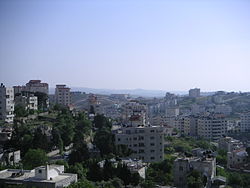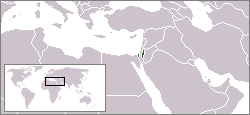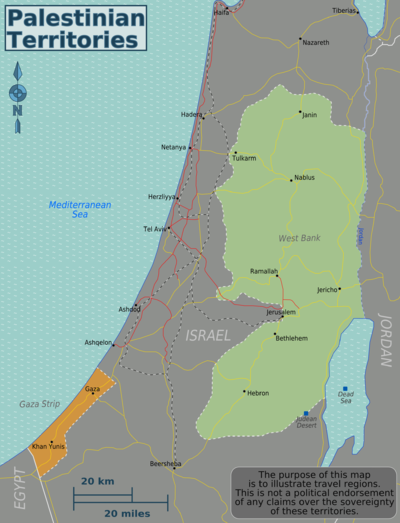| State of Palestine | |
 | |
Location  | |
Coat of arms and flag  | |
| Capital | Ramallah |
|---|---|
| Government | Semi-presidential republic |
| Currency | Jordanian Dinar (JOD) |
| Surface | 27,000 km² |
| Inhabitants | 4 148 000 inhab. (2007) |
| Tongue | Arabic |
| Religion | Islam |
| Electricity | 230V / 50Hz |
| Prefix | 970 |
| TLD | .ps |
| Time zone | UTC 2 |
State of Palestine (دولة فلسطين, Dawlat Filastin) also called only Palestine, is a state of the Middle East which borders to the west, north and south with theIsrael, to the east with the Jordan and southwest with theEgypt.
To know
Background
At the beginning of the twentieth century, due to the growth of Judeophobia in Europe, many Jews migrated to the present state of Palestine, forming Jewish colonies then under the dominion of the Ottoman Empire. After World War I, many Jews moved to the British Mandate of Palestine, which was ruled by the United Kingdom on behalf of the League of Nations. The rise of Jewish settlements in Palestine created discontent among the Palestinians. After the Second World War, a considerable number of the Jewish Holocaust survivors moved to Palestine with the intention of founding a state there. The UN decided that Palestine should be divided into two states, one Palestinian and one Jewish. Thus Israel was founded by the Jews, but the Arab countries were against it and therefore the first Arab-Israeli war broke out and was won by Israel. Thousands of Palestinians were driven out of Palestine and therefore forced to take refuge in refugee camps in Lebanon, Jordan and Syria. At the beginning of the second half of the twentieth century, Israel occupied the territories of the current state of Palestine. Organizations against the Israeli occupation of Palestine were born in the occupied territories which favored actions of guerrilla and terrorism against Israel, which responded with bloody reprisals.
Spoken languages
L'Arabic is the predominant language in Palestine, although a particular dialect of the area (il Palestinian). There is an important minority of language speakers Jewish, including Palestinians who usually work in Israel.
Territories and tourist destinations

Urban centers
- Bethlehem - Ancient city very similar to many others in the West Bank; it hosts Christian holy places, such as the Church of the Nativity; it is a UNESCO World Heritage Site.
- Gaza - The largest city in Palestine, with 450,000 people. It overlooks the Mediterranean and is the administrative capital of the Gaza Governorate, but was heavily damaged during the wars between Israel and Hamas.
- Jericho - The "oldest city in the world," and is about 400m below sea level.
- Hebron - In this city there are glass and ceramic industries; it is divided into two parts, one part is administered by Israel, the other is administered by Palestine.
- Jenin - The northernmost city in the West Bank, just 26 km from Nazareth.
- Nablus - It is considered the commercial capital of the West Bank, is known for its historic center and its furniture trade.
How to get
The border control of Palestine is under the control of Israel, which has also imposed an air blockade, rendering the two existing airports inoperative; this means that entry has to be done through some of the border states.
The most common method of entry is through Israel: most tourists arrive at Ben Gurion Airport in Tel Aviv and then they go by taxi or other means of land transport to one of the checkpoints that limit the areas under the Palestinian administration. From Jerusalem it is easy to reach nearby cities such as Bethlehem is Ramallah, as well as organized tours that cross the Jordan Valley near the Dead Sea.
Entry requirements
Italian citizens with a passport can stay in the State of Palestine for 90 days without a visa only for tourism, while for other purposes it will be necessary to apply for a visa in Israel before entry; however, it is necessary to comply with the Israeli entry requirements, as you can enter almost exclusively from the relevant territory.
Palestinians who do not have a residence card a Jerusalem they cannot enter the State of Palestine if they come from Israeli airports due to a law of that state.
By plane
| To learn more, see: Airports in Israel. |
Although 4 airports are recognized, one of which is international, these are all abandoned, uninhabitable or disused since the early 2000s and therefore it can be said that it is not possible to enter the State of Palestine exploiting air links. However, there are two heliports in the region.
- 1 Ramallah Heliport (IATA: ZDM) (Ramallah). It is an airstrip rebuilt after military attacks by the Israeli army. Here, two helicopters, mainly military and government (both foreign and Palestinian), can land at the same time, and there is also a mausoleum that can be visited. There was also a heliport in Gaza, but it is no longer accessible. The nearest active international airport is at Tel Aviv, but still moving from Israel to Palestine could prove to be very difficult.
How to get around
What see
What to do
Currency and purchases
The national currency is the Israeli new shekel (ILS) Here are the links to know the current exchange rate with the main world currencies:
| (EN) With Google Finance: | AUDCADCHFEURGBPHKDJPYUSD |
| With Yahoo! Finance: | AUDCADCHFEURGBPHKDJPYUSD |
| (EN) With XE.com: | AUDCADCHFEURGBPHKDJPYUSD |
| (EN) With OANDA.com: | AUDCADCHFEURGBPHKDJPYUSD |
Although the official currency is the new Israeli shekel, there are also other currencies: the Jordanian dinar is used in the West Bank, while the Egyptian pound is used in the Gaza Strip. In tourist areas, merchants have no problem accepting the dollar or euro. Large souvenir shops have international credit card systems.
At the table
As in much of the Middle East, the most common dishes are shawarma, falafel and hummus. In all the tables you will find the pita to accompany the meals. In the West Bank, meals are based on rice and meat and one of the most common dishes in this region is mansaf, consisting of lamb, rice and dried yogurt. Gaza cuisine is highly influenced by Egyptian cuisine (including the use of garlic and chilli).
Drinks
Alcohol, as in other Arab countries, is difficult to find, but not impossible (due to the important Christian minority); Taybeh beer, whose owners are Christians, is the only local production.
Tourist infrastructure
Events and parties
Safety
Before embarking on the journey consult:
- Safe travel - Ministry of Foreign Affairs (Farnesina) (Country safety information).
The first thought that springs to mind when going to Palestine is security: the conflict between Israel and Palestine is one of the oldest conflicts still in existence today. Although the conflict is ongoing, there are periods of relative calm and others of greater tension. Therefore, before embarking on a trip to Palestine it is always better to inquire.
Health situation
Respect the customs
- Many of the attractions in Palestine are related to the shrines of Islam, Christianity or Judaism. Respect these places, speaking in a low voice, not interrupting prayers and not wearing light clothing that can be considered provocative. In many places it may be forbidden to enter with bare shoulders or shorts, while in mosques it is mandatory for women to cover their heads (or in some cases their entire face).
- The Israeli occupation is a topic and it is worth talking to the locals about it to understand their point of view. However, it is best to avoid getting into discussions on this topic; many people have been victims of war and very sensitive topics can easily be touched upon.
- Avoid symbols that can be associated with Israel. The Star of David is one of the emblems of the Israeli Defense Forces and can be considered an insult if it is displayed during a visit to Palestine. Likewise, avoid driving cars with an Israeli license plate.
How to keep in touch
Other projects
 Wikipedia contains an entry concerning State of Palestine
Wikipedia contains an entry concerning State of Palestine Commons contains images or other files on State of Palestine
Commons contains images or other files on State of Palestine Wikiquote contains quotes from or about State of Palestine
Wikiquote contains quotes from or about State of Palestine

![]() Afghanistan ·
Afghanistan · ![]() Saudi Arabia ·
Saudi Arabia · ![]() Bahrain ·
Bahrain · ![]() Bangladesh ·
Bangladesh · ![]() Bhutan ·
Bhutan · ![]() Burma ·
Burma · ![]() Brunei ·
Brunei · ![]() Cambodia ·
Cambodia · ![]() China ·
China · ![]() North Korea ·
North Korea · ![]() South Korea ·
South Korea · ![]() United Arab Emirates ·
United Arab Emirates · ![]() Philippines ·
Philippines · ![]() Japan ·
Japan · ![]() Jordan ·
Jordan · ![]() India ·
India · ![]() Indonesia ·
Indonesia · ![]() Iran ·
Iran · ![]() Iraq ·
Iraq · ![]() Israel ·
Israel · ![]() Kyrgyzstan ·
Kyrgyzstan · ![]() Kuwait ·
Kuwait · ![]() Laos ·
Laos · ![]() Lebanon ·
Lebanon · ![]() Maldives ·
Maldives · ![]() Malaysia ·
Malaysia · ![]() Mongolia ·
Mongolia · ![]()
![]()
![]() Nepal ·
Nepal · ![]() Oman ·
Oman · ![]() Pakistan ·
Pakistan · ![]() Qatar ·
Qatar · ![]() Singapore ·
Singapore · ![]() Syria ·
Syria · ![]() Sri Lanka ·
Sri Lanka · ![]() Tajikistan ·
Tajikistan · ![]() Thailand ·
Thailand · ![]() East Timor ·
East Timor · ![]() Turkmenistan ·
Turkmenistan · ![]() Uzbekistan ·
Uzbekistan · ![]() Vietnam ·
Vietnam · ![]() Yemen
Yemen
States with limited recognition: ![]() State of Palestine ·
State of Palestine · ![]() Taiwan
Taiwan
Only physically Asian states[1]: ![]() Armenia ·
Armenia · ![]() Azerbaijan[2] ·
Azerbaijan[2] · ![]() Cyprus ·
Cyprus · ![]() Georgia[2] ·
Georgia[2] · ![]() Kazakhstan ·
Kazakhstan · ![]() Russia ·
Russia · ![]() Turkey
Turkey
States de facto independent: ![]() Abkhazia[2] ·
Abkhazia[2] · ![]() Artsakh ·
Artsakh · ![]() Northern Cyprus ·
Northern Cyprus · ![]() South Ossetia[2]
South Ossetia[2]
Addictions Australian: ![]() Cocos and Keeling Islands ·
Cocos and Keeling Islands · ![]() Christmas Island
Christmas Island
Addictions British: ![]() Akrotiri and Dhekelia[3] ·
Akrotiri and Dhekelia[3] · ![]() British Indian Ocean Territory
British Indian Ocean Territory
Partially Asian states: ![]() Egypt (Sinai) ·
Egypt (Sinai) · ![]() Greece (North Aegean Islands, Dodecanese) ·
Greece (North Aegean Islands, Dodecanese) · ![]() Russia (Asian Russia)
Russia (Asian Russia) ![]() Turkey (Asian Turkey)
Turkey (Asian Turkey)
